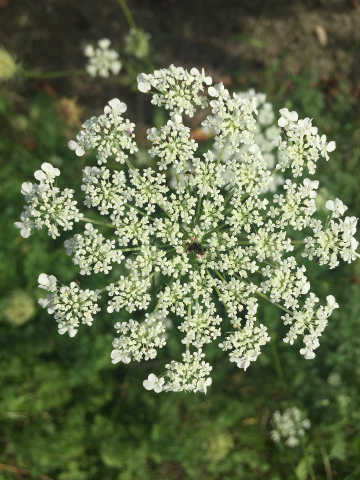

PHOTO COURTESY OF EILEEN K. SAWYER
Queen Anne’s Lace with its characteristic tiny dark flower at the center of the large flowerhead.
July 27, 2018, Page A10-11
NATURE NOTES
By Annie Reid
Westborough Community Land Trust
The queen of July’s field wildflowers
It really feels like summer when the field wildflowers bloom. A favorite this month, with large lacy white flowerheads and parsley-like leaves, is Queen Anne’s Lace, a non-native plant with some very different descriptive names.
With its royal name, Queen Anne’s Lace (Daucus carota) arrived in North America with the English colonists and became established in the wild. In Massachusetts today, it is regarded as naturalized, not invasive, although Ohio, Michigan, Iowa and Washington list it as a noxious weed.
The flat or slightly dome-shaped white flowerheads of Queen Anne’s Lace are easy to spot in dry fields and on roadsides. They’re 2-4 inches wide and appear from June through September. Each flowerhead contains many clusters of small 5-petaled flowers. Look closely and you’ll probably spot a single tiny dark purple flower at the center of most flowerheads.
Why the name Queen Anne’s Lace? It apparently refers to a British monarch’s fondness for wearing lace on her clothing in the early 1700s. Lore has it that the single dark flower in the flowerhead represents a drop of blood that fell from Queen Anne’s finger as she made lace. The name might also refer to Queen Anne’s grandmother, Anne of Denmark, the wife of an English king about a century earlier.
These days, the flowerheads of Queen Anne’s Lace can provide some fun for kids and families. Simply pick some Queen Anne’s Lace (but note the caution below) and put it in water that has been colored with food coloring (vegetable dye). The next day – presto! – the white flowers should be lightly colored with whatever color you added to the water.
Queen Anne’s Lace came to us from England, but the English got it from the Dutch in Shakespeare’s time (Elizabethan England, late 1500s). The plant itself originated in Afghanistan and vicinity more than 2,000 years ago. From there it spread both east and west, probably due to its food and medicinal value. A more everyday name for it is wild carrot.
Today’s carrots likely originated from Queen Anne’s Lace. Both belong to the same species but different subspecies. If you dig up a Queen Anne’s Lace plant, you’ll see that its deep taproot is white, not orange like our carrots, but smells faintly of carrot. This root is edible (but best before the flower stalks appear –the plants live for two years but bloom only in the second year).
Like many wild plants, Queen Anne’s Lace was put to an assortment of medicinal uses in the past. Various preparations have been used as a diuretic, an antiseptic, a contraceptive and treatments for gas, urinary stones and worms.
Once its flowers are spent, Queen Anne’s Lace earns itself a fanciful name – bird’s nest. As the flowerheads dry and seeds mature, the flowerheads curl up and inward into a nest-like shape. If you keep an eye on a patch of Queen Anne’s Lace after it blooms, you’ll see this happen. The nests eventually uncurl and seeds fall out.
Birds don’t nest in Queen Anne’s Lace, but it’s a host plant for caterpillars of black swallowtail butterflies. You might notice these large butterflies flitting around a field of it as they look for mates or search for plants on which to lay eggs. The flowers attract many insect pollinators. A few birds such as American goldfinches, ruffed grouse, and ring-necked pheasants eat the seeds.
A caution: If you’re interested in gathering Queen Anne’s Lace, be sure to identify the plant correctly, because our area has a couple of less common but similar-looking poisonous relatives. They are water hemlock (Cicuta maculata), a plant of wet areas, and poison hemlock (Conium maculatum). Look for certain identifying characteristics of Queen Anne’s Lace: the single dark purple flower in the white flowerhead, a hairy stem and hairy leaf stalks, and three-pronged bracts under the flowerhead.
From summer into fall, let your imagination run with the three names – Queen Anne’s Lace, wild carrot, bird’s nest.